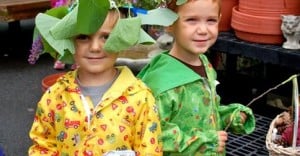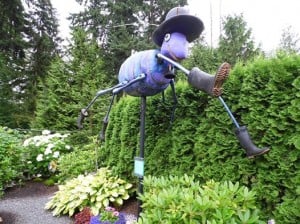Ed knows that gardens are for kids as well as adults. That’s why this veteran television and radio personality, book author, and head of Ed Hume Seeds included a children’s educational garden around his family-owned seed-packing factory in Puyallup, Washington. School groups—and grownups too—come to visit throughout the year.
 However, Ed’s idea of garden education is not botanical Latin. “Fun” is the first word he uses to describe the eight-year-old garden, which was created with the help of everyone who works for the seed company.
However, Ed’s idea of garden education is not botanical Latin. “Fun” is the first word he uses to describe the eight-year-old garden, which was created with the help of everyone who works for the seed company.
Fun, as Ed sees it, can be anything that engages children and adults. For instance, visitors can wander along a pathway that features eighteen small plant displays that illustrate silly word-play puzzles. Everyone guesses at the answers. The arrangement with the shoes on the patch of grass in the photo is Ed’s favorite. “The kids get this one,” he tells me. “It’s three feet in a yard.”
And what kid wouldn’t like to know about plants that eat bugs? Another part of the garden features carnivorous plants, such as Sarracenia and other pitcher plants.
For that active kid in everyone, there’s the experience of a maze that Ed designed. Created with a hundred-and-ten arborvitae trees, which are now eight feet tall, it can take more than an hour to traverse. “The grownups love it as much as the kids,” Ed says.
Plants that grow overhead make leafy shelters. Small children can crawl inside a teepee of scarlet runner beans. Over a walkway, a long pergola supports a tangle of mixed vines—clematis, honeysuckle, and edible hardy akebia—a delight for all the senses.
 Everyone learns a bit about horticultural techniques, such as grafting or tissue culture, in the solar-powered greenhouse. And kids always leave with a cutting they’ve made or a seed they’ve planted in a container.
Everyone learns a bit about horticultural techniques, such as grafting or tissue culture, in the solar-powered greenhouse. And kids always leave with a cutting they’ve made or a seed they’ve planted in a container.
So if you want your own garden to be more inclusive for the children in your life, here are Ed’s tips.
- Involve everyone in the planning stages—and listen to what kids want.
- Make some areas active and devote some places to quiet.
- Give kids simple projects, such as planting large seeds; encourage children to check on their growth.
- Share space in your greenhouse for children’s creativity—it’s not always about garden work. As Ed says, “It’s about fun.”


